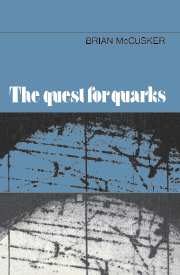4 - The great accelerator hunt
Published online by Cambridge University Press: 05 August 2012
Summary
When Gell-Mann and Zweig put forward their quark hypothesis, the maximum energy available at accelerators was 30 GeV (at Brookhaven National Laboratory, New York). This machine accelerated protons to this energy and then collided them against a stationary target. Machines of this type have now (May 1982) reached energies of 500 GeV (NAL) and 300 GeV (CERN). NAL is the National Accelerator Laboratory (often called Fermilab) at Batavia, Illinois and CERN is the Centre Européenne pour la Recherche Nucleaire at Geneva, Switzerland. But there is a class of accelerator, called colliding beam accelerators, in which, instead of colliding an accelerated beam of particles with a stationary target, we collide a beam with a beam. The first large machine of this type is the Intersecting Storage Rings (ISR) device at CERN. It collides two beams of 30 GeV protons. Because of relativity effects this is equivalent to colliding a beam of ˜ 2000 GeV protons with a stationary target. Recently, CERN has brought its SPS device into operation. This collides two beams, one of protons, the other of anti-protons, at energies of 250 GeV each. This is equivalent to an energy rather greater than 100000 GeV in a machine with a stationary target.
In 1963, 30 GeV seemed a large energy – quite enough to liberate a quark from a proton. One method of checking the quark hypothesis was to collide the protons and search the debris for fractionally-charged particles, with their characteristic ‘low ionisation’ signature. Another method was to examine the protons, looking for their internal structure, in the same way that Rutherford and his co-workers had looked at the structure of atoms.
- Type
- Chapter
- Information
- The Quest for Quarks , pp. 97 - 110Publisher: Cambridge University PressPrint publication year: 1983

